+ Open data
Open data
- Basic information
Basic information
| Entry | Database: PDB / ID: 1aoc | ||||||
|---|---|---|---|---|---|---|---|
| Title | JAPANESE HORSESHOE CRAB COAGULOGEN | ||||||
 Components Components | COAGULOGEN | ||||||
 Keywords Keywords |  COAGULATION FACTOR / CLOTTABLE PROTEIN / CYSTINE KNOT SUPERFAMILY COAGULATION FACTOR / CLOTTABLE PROTEIN / CYSTINE KNOT SUPERFAMILY | ||||||
| Function / homology |  Function and homology information Function and homology information | ||||||
| Biological species |   Tachypleus tridentatus (Chinese horseshoe crab) Tachypleus tridentatus (Chinese horseshoe crab) | ||||||
| Method |  X-RAY DIFFRACTION / X-RAY DIFFRACTION /  SYNCHROTRON / SYNCHROTRON /  MIRAS / Resolution: 2 Å MIRAS / Resolution: 2 Å | ||||||
 Authors Authors | Bergner, A. / Oganessyan, V. / Muta, T. / Iwanaga, S. / Typke, D. / Huber, R. / Bode, W. | ||||||
 Citation Citation |  Journal: EMBO J. / Year: 1996 Journal: EMBO J. / Year: 1996Title: Crystal structure of a coagulogen, the clotting protein from horseshoe crab: a structural homologue of nerve growth factor. Authors: Bergner, A. / Oganessyan, V. / Muta, T. / Iwanaga, S. / Typke, D. / Huber, R. / Bode, W. | ||||||
| History |
|
- Structure visualization
Structure visualization
| Structure viewer | Molecule:  Molmil Molmil Jmol/JSmol Jmol/JSmol |
|---|
- Downloads & links
Downloads & links
- Download
Download
| PDBx/mmCIF format |  1aoc.cif.gz 1aoc.cif.gz | 80.4 KB | Display |  PDBx/mmCIF format PDBx/mmCIF format |
|---|---|---|---|---|
| PDB format |  pdb1aoc.ent.gz pdb1aoc.ent.gz | 65.9 KB | Display |  PDB format PDB format |
| PDBx/mmJSON format |  1aoc.json.gz 1aoc.json.gz | Tree view |  PDBx/mmJSON format PDBx/mmJSON format | |
| Others |  Other downloads Other downloads |
-Validation report
| Arichive directory |  https://data.pdbj.org/pub/pdb/validation_reports/ao/1aoc https://data.pdbj.org/pub/pdb/validation_reports/ao/1aoc ftp://data.pdbj.org/pub/pdb/validation_reports/ao/1aoc ftp://data.pdbj.org/pub/pdb/validation_reports/ao/1aoc | HTTPS FTP |
|---|
-Related structure data
| Similar structure data |
|---|
- Links
Links
- Assembly
Assembly
| Deposited unit | 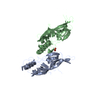
| ||||||||
|---|---|---|---|---|---|---|---|---|---|
| 1 |
| ||||||||
| Unit cell |
|
- Components
Components
| #1: Protein | Mass: 19741.479 Da / Num. of mol.: 2 / Source method: isolated from a natural source Source: (natural)   Tachypleus tridentatus (Chinese horseshoe crab) Tachypleus tridentatus (Chinese horseshoe crab)References: UniProt: P02681 #2: Chemical | ChemComp-SO4 / |  Sulfate Sulfate#3: Water | ChemComp-HOH / |  Water Water |
|---|
-Experimental details
-Experiment
| Experiment | Method:  X-RAY DIFFRACTION / Number of used crystals: 1 X-RAY DIFFRACTION / Number of used crystals: 1 |
|---|
- Sample preparation
Sample preparation
| Crystal | Density Matthews: 2.33 Å3/Da / Density % sol: 47 % | ||||||||||||||||||||||||||||||||||||||||
|---|---|---|---|---|---|---|---|---|---|---|---|---|---|---|---|---|---|---|---|---|---|---|---|---|---|---|---|---|---|---|---|---|---|---|---|---|---|---|---|---|---|
Crystal grow | pH: 4.5 / Details: 0.5 M AMMONIUM SULFATE, 0.1 M NA-ACETATE, PH 4.5 | ||||||||||||||||||||||||||||||||||||||||
| Crystal grow | *PLUS Temperature: 20 ℃ / Method: vapor diffusion, hanging drop | ||||||||||||||||||||||||||||||||||||||||
| Components of the solutions | *PLUS
|
-Data collection
| Diffraction | Mean temperature: 290 K |
|---|---|
| Diffraction source | Source:  SYNCHROTRON / Site: MPG/DESY, HAMBURG SYNCHROTRON / Site: MPG/DESY, HAMBURG  / Beamline: BW6 / Wavelength: 1 / Beamline: BW6 / Wavelength: 1 |
| Detector | Type: MARRESEARCH / Detector: IMAGE PLATE |
| Radiation | Monochromatic (M) / Laue (L): M / Scattering type: x-ray |
| Radiation wavelength | Wavelength : 1 Å / Relative weight: 1 : 1 Å / Relative weight: 1 |
| Reflection | Highest resolution: 2 Å / Num. obs: 23437 / % possible obs: 95.1 % / Redundancy: 1.8 % / Rmerge(I) obs: 0.046 / Rsym value: 0.046 |
| Reflection shell | Resolution: 2→2.07 Å / Redundancy: 1.9 % / Rmerge(I) obs: 0.187 / Rsym value: 0.187 / % possible all: 92.3 |
| Reflection shell | *PLUS % possible obs: 92.3 % |
- Processing
Processing
| Software |
| ||||||||||||||||||||||||||||||||||||||||||||||||||||||||||||
|---|---|---|---|---|---|---|---|---|---|---|---|---|---|---|---|---|---|---|---|---|---|---|---|---|---|---|---|---|---|---|---|---|---|---|---|---|---|---|---|---|---|---|---|---|---|---|---|---|---|---|---|---|---|---|---|---|---|---|---|---|---|
| Refinement | Method to determine structure : :  MIRAS / Resolution: 2→6 Å / Data cutoff high absF: 0.01 / Data cutoff low absF: 100000 MIRAS / Resolution: 2→6 Å / Data cutoff high absF: 0.01 / Data cutoff low absF: 100000 Details: THERE ARE SOME REGIONS THAT ARE BAD, IF THEY ARE AT ALL DEFINED IN THE ELECTRON DENSITY, NAMELY THE N-TERMINAL RESIDUES 1 - 6 AND THE REGIONS AROUND THE CLEAVAGE SITES (13 - 23, 42 - 47). ...Details: THERE ARE SOME REGIONS THAT ARE BAD, IF THEY ARE AT ALL DEFINED IN THE ELECTRON DENSITY, NAMELY THE N-TERMINAL RESIDUES 1 - 6 AND THE REGIONS AROUND THE CLEAVAGE SITES (13 - 23, 42 - 47). THE OCCUPANCY OF THESE RESIDUES HAS BEEN SET TO 0.0. THE R VALUE OF THIS MODEL IS 0.195 AND R FREE IS 0.283.
| ||||||||||||||||||||||||||||||||||||||||||||||||||||||||||||
| Displacement parameters | Biso mean: 39.3 Å2 | ||||||||||||||||||||||||||||||||||||||||||||||||||||||||||||
| Refinement step | Cycle: LAST / Resolution: 2→6 Å
| ||||||||||||||||||||||||||||||||||||||||||||||||||||||||||||
| Refine LS restraints |
| ||||||||||||||||||||||||||||||||||||||||||||||||||||||||||||
| LS refinement shell | Resolution: 2→2.07 Å / Total num. of bins used: 10
| ||||||||||||||||||||||||||||||||||||||||||||||||||||||||||||
| Software | *PLUS Name:  X-PLOR / Classification: refinement X-PLOR / Classification: refinement | ||||||||||||||||||||||||||||||||||||||||||||||||||||||||||||
| Refinement | *PLUS | ||||||||||||||||||||||||||||||||||||||||||||||||||||||||||||
| Solvent computation | *PLUS | ||||||||||||||||||||||||||||||||||||||||||||||||||||||||||||
| Displacement parameters | *PLUS | ||||||||||||||||||||||||||||||||||||||||||||||||||||||||||||
| LS refinement shell | *PLUS Rfactor obs: 0.32 |
 Movie
Movie Controller
Controller



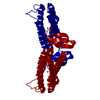

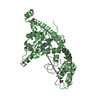
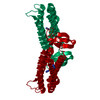
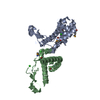
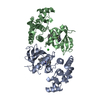

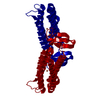
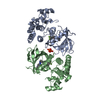
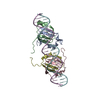
 PDBj
PDBj




